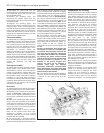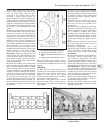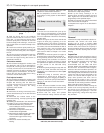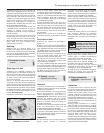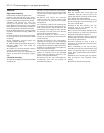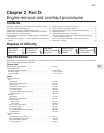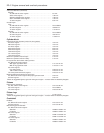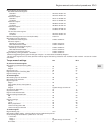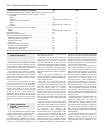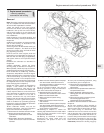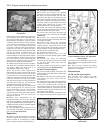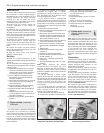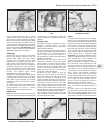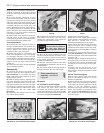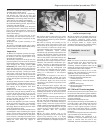
Torque wrench settings (continued) Nm lbf ft
Main bearing ladder casting - aluminium block engines (models with grooved
No 5 main bearing half-shell fitted to cylinder block - see text):
11 mm bolts:
Stage 1 . . . . . . . . . . . . . . . . . . . . . . . . . . . . . . . . . . . . . . . . . . . . . . 20 15
Stage 2 . . . . . . . . . . . . . . . . . . . . . . . . . . . . . . . . . . . . . . . . . . . . . . Tighten through a further 55º
Fully slacken bolt, then tighten to:
Stage 3 . . . . . . . . . . . . . . . . . . . . . . . . . . . . . . . . . . . . . . . . . . . . . . 20 15
Stage 4 . . . . . . . . . . . . . . . . . . . . . . . . . . . . . . . . . . . . . . . . . . . . . . Tighten through a further 45º
6 mm bolts . . . . . . . . . . . . . . . . . . . . . . . . . . . . . . . . . . . . . . . . . . . . . 8 6
Main bearing cap bolts (cast-iron block engine):
Stage 1 . . . . . . . . . . . . . . . . . . . . . . . . . . . . . . . . . . . . . . . . . . . . . . . . 20 15
Stage 2 . . . . . . . . . . . . . . . . . . . . . . . . . . . . . . . . . . . . . . . . . . . . . . . . Tighten through a further 45º
Oil pressure switch . . . . . . . . . . . . . . . . . . . . . . . . . . . . . . . . . . . . . . . . . 28 21
Engine-to-transmission bolts . . . . . . . . . . . . . . . . . . . . . . . . . . . . . . . . . 35 26
Engine/transmission left-hand mounting:
Mounting bracket-to-transmission nuts . . . . . . . . . . . . . . . . . . . . . . . 20 15
Mounting bracket-to-body bolts . . . . . . . . . . . . . . . . . . . . . . . . . . . . . 25 18
Mounting rubber nuts . . . . . . . . . . . . . . . . . . . . . . . . . . . . . . . . . . . . . 20 15
Centre nut . . . . . . . . . . . . . . . . . . . . . . . . . . . . . . . . . . . . . . . . . . . . . . 65 48
Engine/transmission rear mounting:
Mounting-to-cylinder block bolts . . . . . . . . . . . . . . . . . . . . . . . . . . . . 40 30
Mounting link-to-mounting bolt . . . . . . . . . . . . . . . . . . . . . . . . . . . . . 70 52
Mounting link-to-body bolt . . . . . . . . . . . . . . . . . . . . . . . . . . . . . . . . . 50 37
Engine/transmission right-hand mounting bracket nuts . . . . . . . . . . . . 45 33
2D•4 Engine removal and overhaul procedures
1 General information
Included in this Part of Chapter 2 are details
of removing the engine/transmission from the
car and general overhaul procedures for the
cylinder head, cylinder block/crankcase and
all other engine internal components.
The information given ranges from advice
concerning preparation for an overhaul and
the purchase of replacement parts, to detailed
step-by-step procedures covering removal,
inspection, renovation and refitting of engine
internal components.
After Section 5, all instructions are based
on the assumption that the engine has been
removed from the car. For information
concerning in-car engine repair, as well as the
removal and refitting of those external
components necessary for full overhaul, refer
to Part A, B or C of this Chapter (as
applicable) and to Section 5. Ignore any
preliminary dismantling operations described
in Part A, B or C that are no longer relevant
once the engine has been removed from the
car.
2 Engine/transmission
removal - preparation and
precautions
If you have decided that an engine must be
removed for overhaul or major repair work,
several preliminary steps should be taken.
Locating a suitable place to work is
extremely important. Adequate work space,
along with storage space for the car, will be
needed. If a workshop or garage is not
available, at the very least, a flat, level, clean
work surface is required.
If possible, clear some shelving close to the
work area and use it to store the engine
components and ancillaries as they are
removed and dismantled. In this manner the
components stand a better chance of staying
clean and undamaged during the overhaul.
Laying out components in groups together
with their fixing bolts, screws etc will save
time and avoid confusion when the engine is
refitted.
Clean the engine compartment and
engine/transmission before beginning the
removal procedure; this will help visibility and
help to keep tools clean.
The help of an assistant should be
available; there are certain instances when
one person cannot safely perform all of the
operations required to remove the engine
from the vehicle. Safety is of primary
importance, considering the potential hazards
involved in this kind of operation. A second
person should always be in attendance to
offer help in an emergency. If this is the first
time you have removed an engine, advice and
aid from someone more experienced would
also be beneficial.
Plan the operation ahead of time. Before
starting work, obtain (or arrange for the hire of)
all of the tools and equipment you will need.
Access to the following items will allow the task
of removing and refitting the
engine/transmission to be completed safely
and with relative ease: an engine hoist - rated
in excess of the combined weight of the
engine/transmission, a heavy-duty trolley jack,
complete sets of spanners and sockets as
described at the rear this manual, wooden
blocks, and plenty of rags and cleaning solvent
for mopping up spilled oil, coolant and fuel. A
selection of different sized plastic storage bins
will also prove useful for keeping dismantled
components grouped together. If any of the
equipment must be hired, make sure that you
arrange for it in advance, and perform all of the
operations possible without it beforehand; this
may save you time and money.
Plan on the vehicle being out of use for
quite a while, especially if you intend to carry
out an engine overhaul. Read through the
whole of this Section and work out a strategy
based on your own experience and the tools,
time and workspace available to you. Some of
the overhaul processes may have to be
carried out by a Peugeot dealer or an
engineering works - these establishments
often have busy schedules, so it would be
prudent to consult them before removing or
dismantling the engine, to get an idea of the
amount of time required to carry out the work.
When removing the engine from the vehicle,
be methodical about the disconnection of
external components. Labelling cables and
hoses as they removed will greatly assist the
refitting process.
Always be extremely careful when lifting the
engine/transmission assembly from the
engine bay. Serious injury can result from
careless actions. If help is required, it is better
to wait until it is available rather than risk
personal injury and/or damage to components
by continuing alone. By planning ahead and
taking your time, a job of this nature, although
major, can be accomplished successfully and
without incident.
On all models covered by this manual, the
engine and transmission are removed as a
complete assembly, upwards and out of the
engine bay. The engine and transmission are
then separated with the assembly on the
bench.



